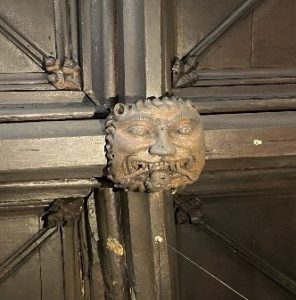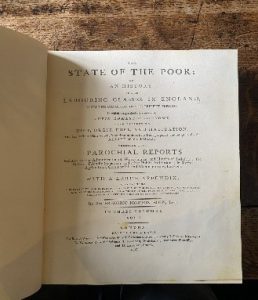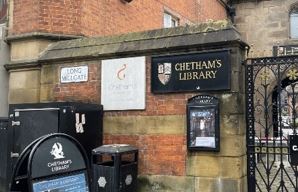Social Anthropology among the Archives: Chetham’s Library Fieldtrip
Written by Hannah Murphy
(SoSS Undergraduate, University of Manchester)
Introduction
Taking teaching out of the classroom, our social anthropology students on the module ‘Ethnographies and Adventures in Manchester’, taught by Dr Katherine Smith (Social Anthropology) recently attended a field trip to Chetham’s Library, where they delved into to connections between local history, culture, and literature of the oldest English public library.
Historical significance
 Chetham’s Library, founded in 1653 in Manchester, is the oldest public library in England and is an independent charity.
Chetham’s Library, founded in 1653 in Manchester, is the oldest public library in England and is an independent charity.
Originally built in 1421 for priests, the site is one of England’s most complete medieval domestic complexes. In 1653, Humprey Chetham established a “Hospital School and Library” to house and educate poor boys, offering free access to university-level books.
Over time, the institution evolved, becoming a grammar school in 1950 and a specialist music school in 1969. Today, Chetham’s Library is a unique cultural institution that blends heritage, music, and education in the heart of Manchester.
During the tour around Chetham’s Library we unravelled the centuries of stories, explored the cultural artifacts and uncovered narratives woven into ancient texts and examining the social contexts that shaped them.
Below are a few photos of some hidden gems I found from the trip with their historical significance.
The Audit room
Here is where guests/dignitaries would have been welcomed and Fellows of the College would have met.

Pictured right, is Atom’s Cruciform inspired by sketches of the atom by English chemist, physicist, and meteorologist John Dalton.
With reference to the colours, red is symbolic of lifeblood, white signifies the stars and black represents outer space.
NASA’s Perseverance over on Mars captured the world throughout the pandemic, this piece represents the world of science and faith standing firm, side by side.


If you look up at the ceiling, you’ll notice some quirky moral reminders to be ‘good’ and the consequences of evil. The photo on the left is a devil eating an angel whore.

Also in the audit room is tribute to John Dee who is a significant figure in Chetham’s Library history.
Appointed Warden of the college in 1595, Dee was renowned for his multifaceted contributions. He is widely recognized as an influential figure, gaining fame as an astrologer, alchemist, and occultist.
However, Dee’s significance extends beyond these mystical pursuits; he also made significant contributions as a Renaissance scientist, mathematician, and philosopher. Dee’s diverse interests and expertise reflect the interdisciplinary nature of his pursuits during this period.
Hidden gems in Chetham’s Library
“Animalium Mar. Ordo XII”, Gessner Conrad 1558.
Conrad Gessner (1516-1565) was a Swiss physician, naturalist, bibliographer and philologist.
The text in this photo is an extract from “Historia Animalium” (1558) which explores the interactions of taxonomy, cultural influences and scholarly traditions in the mid-sixteenth century.
His work offered insights into contemporary perspectives on cetaceans, the classification of monsters and belief in sea-monsters.

S-shaped stools
Dotted all around the library are 24 carved stools with ‘S’ shaped hand holds which were provided as seats for readers to move around the shelves.
The S shape is the perfect handle to grip and pick up the chair and move it wherever!
These are still used today, and you can sit on them!


“Discoverie of Witchcraft”, Reginald Scot 1584.
What I found remarkable was that just below this extract lies he “Discoverie of Witchcraft” by Reginald Scot, which is a significant piece of work in the history of witchcraft and the occult. The book aimed to debunk the witchcraft and magic myths and expose the fallacies surrounding witch trials and supernatural practices when the belief in witchcraft during the 16th century was so widespread.
The contrast between one author believing in sea-monsters compared to another who was a witchcraft sceptic producing work in the same period was really interesting!

Inside library chambers
All the historic tomes were shelved on dark oak bookshelves and locked away in different cases and alcoves.
There is a newspaper extract on display in this alcove which headlines “CHILDREN TRADING IN THE STREETS”. This gave me insight into the reality of what it was like to be a child during this time period, the fact it is displayed in the library supports Humphrey Chetham’s belief that children should have access to education.
The Reading room
The final stop on our adventure around Chetham’s Library was the large Reading room, where studying and important meetings would take place.

There is a large portrait of Humphrey and under the window archway is the famous alcove where Karl Marx and Friedrich Engles studied to produce “The Communist Manifesto” 1848. We got to sit at the very same spot of both Marx and Engles!











0 Comments